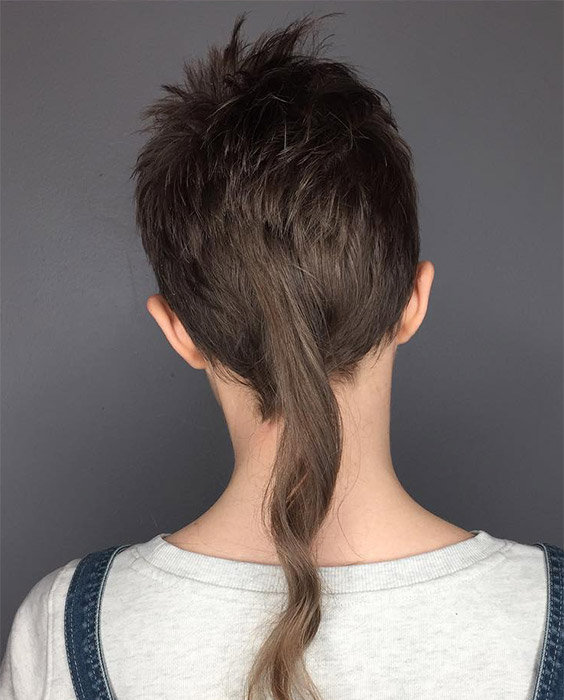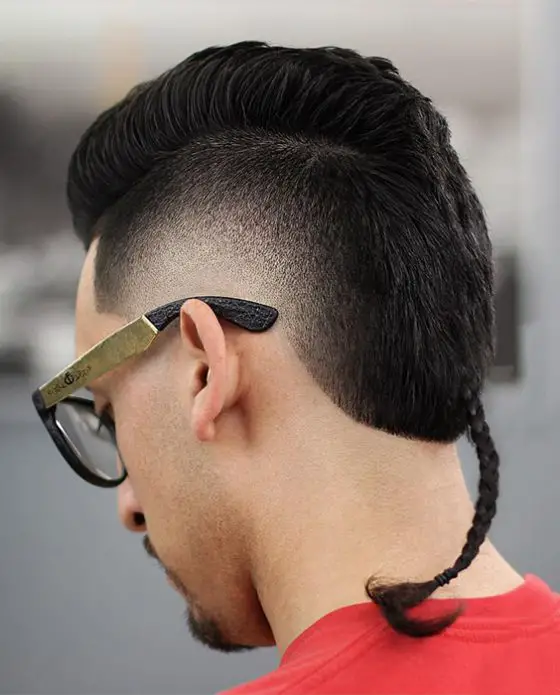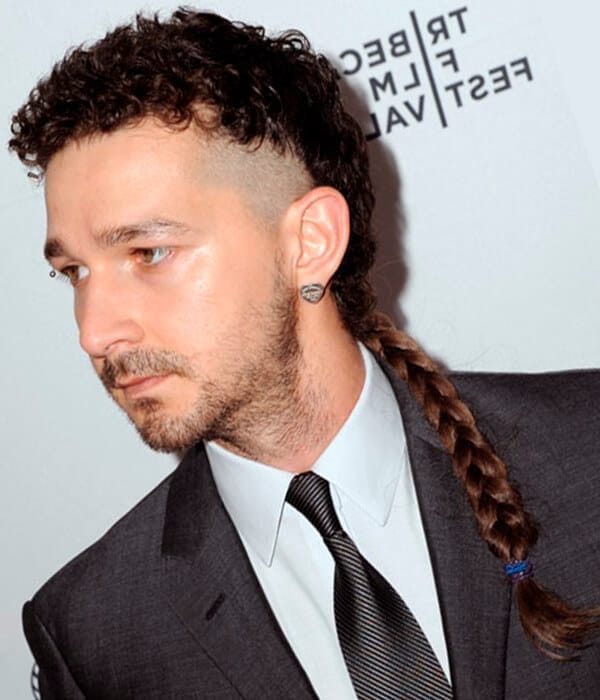The Rat Tail: A Rebellious Strand's Resurgence
The rat tail, a long strand of hair at the nape of the neck, has long been one of the most divisive hairstyles in history. Often misunderstood and frequently dismissed, this unique coiffure is far more than just a fleeting trend from the 1980s; it's a statement, a symbol, and now, it's making an unexpected comeback, marrying nostalgia with bold creativity.
From its ancient origins in the Far East to its modern resurgence on celebrities and influencers, the rat tail embodies a spirit of defiance and individuality. This article delves deep into its fascinating history, explores its cultural significance, dissects its many variations, and examines why this once-notorious look continues to capture imaginations and spark conversations across generations and subcultures.
Table of Contents
- What Exactly is a Rat Tail Hairstyle?
- A Journey Through Time: The Rat Tail's Ancient Roots
- The Rat Tail as a Symbol: Defiance, Individuality, and Subculture
- Stylistic Versatility: Embracing the Modern Rat Tail
- The Rat Tail's Resurgence: Nostalgia Meets Modernity
- Dispelling Myths: The Name's Curious Origin
- Is the Rat Tail Right for You? Zumbo's Advice and Beyond
- Maintaining Your Rat Tail: Tips for Longevity and Style
What Exactly is a Rat Tail Hairstyle?
At its core, a **rat tail** is a distinctive hairstyle characterized by a long, thin section of hair left at the nape of the neck, while the rest of the hair is typically cut much shorter. Imagine the "forbidden love child of the ponytail and mullet," as some have playfully described it. While mullets are known for being "short in front and long in back," the rat tail takes this concept to a more extreme, isolated degree.
- Mathilda May Hot
- How Old Is Veeze
- Onlyfans Lowkeydeadinside
- Nurse Patti Tampa
- Palatka Flooring Palatka Fl
Unlike the broader, more integrated length of a mullet, the rat tail is usually a very small section, perhaps just a square inch (2 square centimeters) at the base of the hairline. This isolated strand is what gives it its unique and often controversial appearance. Aptly named after the rear end of its rodent counterpart, the hairstyle is instantly recognizable and has cemented its place in the annals of bold hair choices.
A Journey Through Time: The Rat Tail's Ancient Roots
While many associate the **rat tail** hairstyle primarily with the rebellious fashion of the 1980s, its true origins stretch much further back in time. Far from being a mere product of late 20th-century counter-culture, the rat tail hairstyle dates back to ancient works of art and religion in the Far East. Historical records and artistic depictions from various Asian cultures reveal similar long, thin strands of hair worn as symbols of status, spirituality, or identity.
Beyond the Far East, the concept of a distinct, elongated lock of hair also appears in other historical contexts. Some cultural historians note that variations of isolated long strands were present in certain Native American heritage traditions, often carrying deep spiritual or tribal significance. This rich and tangled lineage demonstrates that the **rat tail** is not a fleeting modern invention but a recurring motif in human expression, adapting and transforming across diverse civilizations and eras. Its enduring presence, even if often in the background, speaks to a primal human desire for unique self-expression through hair.
The Rat Tail as a Symbol: Defiance, Individuality, and Subculture
The **rat tail** hairstyle is notorious for its tacky name and rebellious reputation, and it has undeniably found its most prominent voice as a symbol of defiance and individuality. In the vibrant and often provocative landscapes of punk, pop, and queer culture, the rat tail became more than just a haircut; it transformed into a powerful emblem of non-conformity.
For those operating within fringe groups of society, the rat tail could be seen as a direct expression of cultural identity. It was a visible rejection of mainstream norms, a sartorial middle finger to conventional beauty standards. This edgy trend, with its bold and unapologetic statement, resonated deeply with individuals who sought to stand out and celebrate their unique identities. Whether subtle or bold, the presence of a rat tail signaled a wearer who was unafraid to challenge expectations and embrace their true self, making it a compelling choice for those looking to convey a message without uttering a single word.
Stylistic Versatility: Embracing the Modern Rat Tail
Far from being a one-dimensional style, the **rat tail** has evolved significantly, proving its remarkable versatility. Today's iteration often comes with a modern twist, showcasing how this controversial look can be adapted to suit various aesthetics and personal preferences. The beauty of the modern rat tail lies in its adaptability, allowing wearers to personalize it in countless ways.
Beyond the Basic: Braids, Dreads, and More
The classic rat tail usually hangs naturally, a simple, unadorned strand. However, its potential for customization is immense. It can be transformed in numerous ways:
- Braided: A common and popular choice, braiding adds texture and neatness, often making the tail appear more deliberate and refined.
- Treated as a Dread: For those leaning into a more bohemian or alternative vibe, the rat tail can be matted and formed into a small dreadlock, adding a unique, textured element.
- Permed or Curled: Adding waves or tight curls can give the tail a playful bounce or a more voluminous appearance, softening its sharp lines.
- Straightened: For a sleek, minimalist look, the tail can be meticulously straightened, emphasizing its length and precision.
- Poofed: A less common but equally bold option, the tail can be styled with volume, creating a small, rounded puff at the end.
- Beaded or Bleached: To further enhance its individuality, the rat tail is often adorned with beads or dyed a contrasting color, making it an even more striking focal point.
These variations allow the wearer to truly make the **rat tail** their own, moving it beyond a simple haircut to a form of personal art.
The Spartan Connection: A Bold New Edge
In its latest evolution, the **rat tail** hairstyle has resurfaced with a modern twist, now incorporating elements of Spartan-style haircuts. This fusion creates a bold and unique statement in men's hairstyling. The Spartan haircut, typically characterized by short sides and back with a slightly longer top, provides an ideal canvas for the rat tail to emerge as a singular, powerful statement.
This combination offers a blend of ancient warrior aesthetic with a contemporary edge, appealing to those who desire a strong, distinctive look that commands attention. The clean lines of the Spartan cut accentuate the deliberate nature of the rat tail, transforming it from a mere afterthought into a focal point of strength and unconventional style.
Celebrity & Influencer Spotlight
The resurgence of the **rat tail** has been significantly fueled by its adoption by celebrities and influencers across various platforms. From subtle nods to the style to bold, unmistakable declarations, high-profile figures are showcasing the versatility and appeal of this once-controversial look. For instance, the discussion around "HBO's The Idol" and its portrayal of characters with unique hairstyles has brought the rat tail back into the cultural conversation, demonstrating its continued relevance in modern media.
These trendsetters are rocking the rat tail in different lengths, colors, and styles, proving that it can be adapted for a wide range of personal brands. Whether it's a barely-there wisp or a thick, braided statement, their embrace of the style normalizes it and encourages a new generation to experiment with its rebellious charm. Their visibility helps to redefine the rat tail, shifting perceptions from "tacky" to "trendy" and cementing its place as a legitimate, albeit edgy, fashion choice.
The Rat Tail's Resurgence: Nostalgia Meets Modernity
The **rat tail** hairstyle, once a hallmark of 1980s fashion, has made a definitive comeback, proving that what goes around often comes back around in the cyclical world of trends. This latest wave isn't just about pure nostalgia; it's about marrying the rebellious spirit of the past with bold creativity for the present. Why is this divisive look finding its way back into our hearts and onto our heads?
Part of its appeal lies in its inherent uniqueness. In an era saturated with similar looks, the rat tail offers an immediate way to stand out. It speaks to a growing desire for individuality and a rejection of conformity, echoing its original punk and counter-culture roots. Moreover, the modern interpretations, often cleaner, more stylized, and intentionally integrated into contemporary cuts like the Spartan style, make it more palatable and adaptable for a wider audience. It's a nod to the past, but with a fresh, confident attitude that resonates with today's adventurous fashion sensibilities.
Dispelling Myths: The Name's Curious Origin
The name "rat tail" itself is undoubtedly notorious and has contributed to many misconceptions about the hairstyle. It's aptly named after the rear end of its rodent counterpart, and for many, the very mention of a "rat's tail" conjures images of something cold, slimy, and gross. This perception often unfairly taints the hairstyle, associating it with negative connotations.
However, any rat owner can tell you that these common misconceptions about actual rat tails are far from the truth. They are often described as "soft and special." While it's true that rats have tails—something almost everyone knows—most people who do not own rats and never interact with them have distorted views. This disparity highlights how a name, even if visually descriptive, can shape public opinion. The hairstyle, despite its "tacky name," is a purely human expression of style, separate from its biological namesake, yet forever linked by a shared characteristic of a thin, elongated form.
Is the Rat Tail Right for You? Zumbo's Advice and Beyond
Considering a **rat tail**? This controversial look isn't for the faint of heart, but it certainly makes a statement. As some stylists might advise, "Be bold and brave!" This hairstyle requires a certain level of confidence to pull off, as it's designed to be noticed and to spark conversation.
Before committing, consider your personal style, your comfort with unconventional looks, and how the rat tail might integrate with your overall aesthetic. It's an expression of personality, so ensure it aligns with who you are. Discussing it with a skilled barber or stylist is crucial; they can offer insights into how the style might best suit your hair type, face shape, and desired level of boldness. They can also advise on the best cut for the rest of your hair to complement the isolated strand, ensuring a cohesive and intentional look. Whether you're aiming for subtle rebellion or a full-blown statement, the rat tail offers a unique canvas for self-expression.
Maintaining Your Rat Tail: Tips for Longevity and Style
Once you've embraced the **rat tail**, proper maintenance is key to keeping it looking its best. Because it's an isolated strand, it can be prone to tangles, breakage, or looking unkempt if neglected. Regular washing and conditioning, just like the rest of your hair, are essential. Pay particular attention to the tail itself, ensuring it remains clean and moisturized to prevent dryness and frizz.
If your rat tail is braided, re-braiding it periodically will keep it neat and prevent it from unraveling. For those with a straightened or curled tail, using heat protectant sprays is vital before styling with irons. Trimming the very tip occasionally can help prevent split ends and maintain a clean line. Ultimately, treating your rat tail with care ensures it remains a sharp, intentional part of your look, rather than an afterthought, allowing you to rock this edgy trend with confidence and style for as long as you desire.
The **rat tail** hairstyle, with its rich history and undeniable presence, continues to defy expectations. It's more than just a fleeting trend; it's a testament to the enduring power of hair as a form of personal expression and rebellion. From its ancient roots to its modern resurgence, this long strand at the nape of the neck remains a bold choice for those unafraid to stand out.
Have you ever sported a rat tail, or are you considering this daring look? Share your thoughts and experiences in the comments below! If you found this exploration of the rat tail fascinating, be sure to explore our other articles on iconic hairstyles and their cultural impact.
- Johnny Rivers Wife
- Ncaa Division Ii Baseball
- Aire Barranquilla
- Peter Ellis Kings Guard
- Hory Shet Spongebob

26 Inspiring Rat Tail Hairstyles To Uplift Your Style

26 Inspiring Rat Tail Hairstyles To Uplift Your Style

25 Manly Ways to Rock With Rat Tail Hairstyles (2024 Trends)